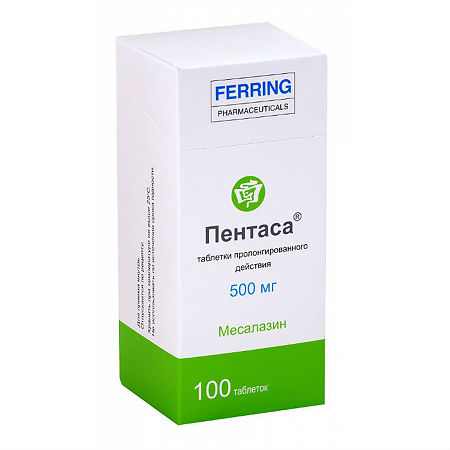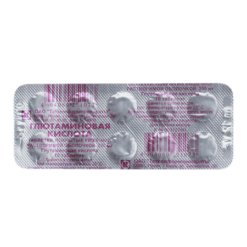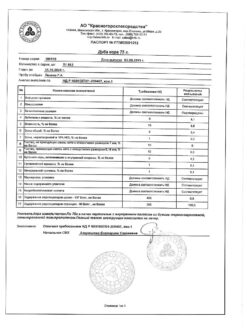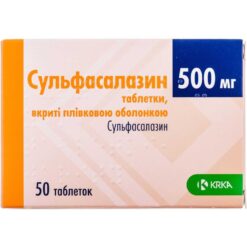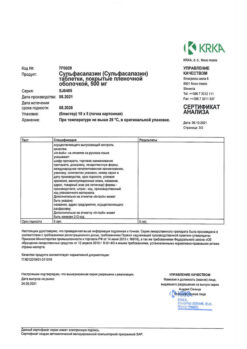No products in the cart.
Pentasa, 500 mg 100 pcs
€1.00
Out of stock
(E-mail when Stock is available)
Description
Mesalazine, 5-aminosalicylic acid, is the active component of sulfasalazine used for the treatment of ulcerative colitis and Crohn’s disease. The therapeutic effect of mesalazine after oral administration is more due to local effect on inflamed intestinal tissue than to systemic action. According to the available information, the severity of intestinal inflammation in patients with ulcerative colitis is inversely proportional to the concentration of mesalazine in the intestinal mucosa.
In inflammatory bowel disease there is increased migration of leukocytes, increased production of cytokines and derivatives of arachidonic acid (in particular, leukotriene B4), increased formation of free radicals.
The exact mechanism of action of mesalazine is not fully understood, but it has been established that it activates γ-forms of peroxisome proliferator-activated receptors (PPAR-γ) and suppresses the transcription factor NF-κB in the intestinal mucosa. Mesalazine inhibits leukocyte chemotaxis, reduces cytokine and leukotriene production, and reduces free radical formation in inflamed intestinal tissue. The exact importance of each mechanism of action in the realization of the pharmacological action of mesalazine has not been established.
In ulcerative colitis there is an increased risk of colorectal cancer. The action of mesalazine observed in experimental models and during biopsies in patients indicates that mesalazine prevents the development of colorectal cancer associated with ulcerative colitis by inhibiting intracellular and extracellular signaling pathways involved in the development of colorectal cancer in patients with ulcerative colitis.
However, the results of meta-analyses evaluating data from both the target and other patient populations show mixed clinical evidence regarding the beneficial effects of mesalazine in terms of the risk of tumor development associated with nonspecific ulcerative colitis.
Indications
Indications
Active ingredient
Active ingredient
Composition
Composition
One tablet contains:
the active ingredient:
mesalazine 500 mg;
auxiliary substances:
povidone K 29/32 25 mg,
ethylcellulose 6-9 mg,
p> magnesium stearate 1 mg,
talc 9 mg,
microcrystalline cellulose 207 mg.
How to take, the dosage
How to take, the dosage
Tablets are recommended to be taken after meals without chewing or crushing. The tablet may be divided into several parts or dissolved in 50 ml of cold water immediately before ingestion to make it easier to swallow.
Adults
The dosage is adjusted individually. The recommended dose in the acute period is up to 4 g per day, divided into 2-4 doses.
Maintenance therapy
The dosage is adjusted individually. The recommended dose is 2 g of mesalazine per day. For treatment of Crohn’s disease, the drug may be prescribed in a daily dose of up to 4 g divided into several doses.
Children over 6 years of age
There are limited data on the use of mesalazine in children aged 6 to 18 years.
The acute period
The dosage is adjusted individually. The recommended dose in the acute period is 30 to 50 mg of mesalazine per kilogram of body weight per day (mg/kg/day) in several doses, the maximum single dose not more than 75 mg/kg/day, the maximum daily dose not more than 4 g.
The maintenance therapy
The dose is adjusted individually. The recommended maintenance dose is 15 to 30 mg/kg/day, divided into several doses; the maximum daily dose is not more than 2 g (4 g for Crohn’s disease).
In children with body weight less than 40 kg it is recommended to prescribe 1/2 of the adult dose, in children with body weight more than 40 kg it is recommended to prescribe the adult dose.
The duration of therapy is determined by the attending physician.
Interaction
Interaction
There have been no studies of drug interactions of Pentas®.
The incidence of myelosuppressive effects increases with concomitant administration of Pentas® with azathioprine or 6-mercaptopurine or thioguanine, but the mechanism of this interaction has not been established. Regular monitoring of blood counts and adjustment of thiopurine dose is necessary.
The concomitant use of Pentas® and other drugs with nephrotoxicity, such as nonsteroidal anti-inflammatory drugs (NSAIDs) and azathioprine increases the risk of adverse reactions in the kidneys.
The drug Pentas® slows down absorption of cyanocobalamin (vitamin B12), enhances hypoglycemic action of sulfonylurea derivatives, glucocorticosteroids ulcerogenicity, methotrexate toxicity, weakens activity of furosemide, spironolactone, sulfonamides, rifampicin and warfarin, increases the effectiveness of uricosuric medicines (blockers of tubular secretion). When concomitant use of medications mesalazine and digoxin, the absorption of digoxin is reduced.
Special Instructions
Special Instructions
Biochemical blood tests (AST activity, ALT, creatinine concentration in blood plasma), determination of the number of blood cells and express analysis of urine (test strips) should be performed before starting the drug and during treatment by prescription. Patient should be examined again 14 days after start of Pentas ® treatment and then examined 2-3 times more at intervals of 4 weeks. If treatment tolerance is good, repeat examination every 3 months. If other symptoms occur, a physician should be consulted.
Caution should be exercised when treating patients with hypersensitivity to sulfasalazine (risk of allergic reaction to salicylates). Most patients with sulfasalazine intolerance or hypersensitivity to sulfasalazine can take Pentas® without fear of adverse reactions. Patients who have previously taken sulfasalazine with adverse reactions should be under close medical supervision at the start of therapy with Pentas®. In case of acute symptoms of intolerance to the drug (abdominal cramps and pain, fever, severe headache and skin rashes) the drug should be stopped.
The drug is not recommended for patients with impaired hepatic function and patients with impaired hemostasis.
Pentas® is not recommended for patients with impaired renal function. Renal dysfunction detected when taking mesalazine may be due to its nephrotoxicity. Concomitant administration of other nephrotoxic drugs (e.g., NSAIDs or azathioprine) may increase the risk of renal impairment.
Patients with lung disease, including bronchial asthma, should be closely monitored when taking mesalazine.
Pentas® should be used with caution in patients with acute peptic ulcer.
The development of adverse reactions in the heart (myocarditis, pericarditis) has been rarely noted. Serious blood dyscrasia has been noted very rarely. Concomitant use of mesalazine with azathioprine, 6-mercaptopurine or thioguanine may increase the risk of blood dyscrasia. If symptoms of these diseases occur, the drug should be discontinued.
Impact on ability to drive vehicles, mechanisms
Pentas ® does not affect the ability to drive vehicles and mechanisms. In case of adverse events (such as dizziness, etc.) the above mentioned activities should be avoided.
Contraindications
Contraindications
If you have any of the conditions listed, be sure to talk to your doctor before taking this medicine.
Cautions
Patients with pulmonary dysfunction, particularly bronchial asthma, acute gastric or duodenal ulcer, or hemorrhagic diathesis should use the product with caution.
Pentas® should be used with caution in patients with mild to moderate renal/hepatic impairment because decreased elimination rate and increased systemic concentration of mesalazine increase the risk of renal damage.
Side effects
Side effects
The most common symptoms with Pentas® are diarrhea, nausea, abdominal pain, headache, vomiting and skin rashes. Some patients have had hypersensitivity reactions and an increase in body temperature.
The frequency of adverse effects: very common (⥠1/10), common (⥠1/100 to <1/10), infrequent (⥠1/1000 to <1/100), rare (⥠1/10000 to <1/1000), very rare (<1/10000), frequency not determined (no data on the incidence of adverse reactions are available at this time).
System-organ class
Often
Rarely
Very rarely
Liver and biliary tract disorders
/p>
Increased activity of liver enzymes and bilirubin, hepatotoxicity (hepatitis*, cholestatic hepatitis, cirrhosis, liver failure)
Hepatic enzymes and bilirubin
Skin and subcutaneous tissue disorders
Skin rashes (including.Ñ. urticaria, erythema)
Reversible alopecia, Quincke’s edema, erythema multiforme, Stevens-Johnson syndrome
/p>
Muscular and connective tissue disorders
Interstitial nephritis* (acute or chronic), nephrotic syndrome, renal failure (acute/chronic), change in urine color
Gender and mammary gland disorders
Reversible oligospermia
(*) The mechanism of adverse reactions is presumably allergic in nature.
The development of some adverse reactions may be associated with inflammatory bowel disease.
If any of the effects listed in the instructions worsen, or if you notice any other side effects not listed in the instructions, tell your doctor.
Overdose
Overdose
Cases of overdose with Pentas® are rare. In overdose there are no signs of nephrotoxicity or hepatotoxicity, but symptoms of salicylate poisoning may occur.
There are reports of patients who have taken mesalazine at a dose of 8 g for one month without side effects.
There is no specific antidote. Symptomatic and supportive therapy is recommended. Careful monitoring of renal function is necessary during inpatient treatment.
Similarities
Similarities
Additional information
| Shelf life | 3 years. Do not use after the expiration date printed on the package. |
|---|---|
| Conditions of storage | Store at a temperature not exceeding 30 ° C in the original container. Do not freeze. Store out of the reach of children. |
| Manufacturer | Ferring GmbH, Switzerland |
| Medication form | slow-release tablets |
| Brand | Ferring GmbH |
Related products
Buy Pentasa, 500 mg 100 pcs with delivery to USA, UK, Europe and over 120 other countries.

